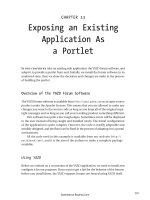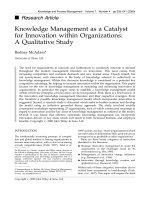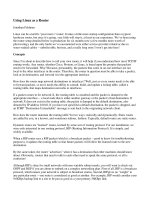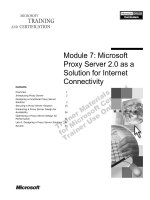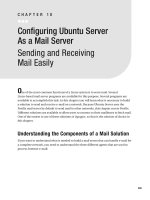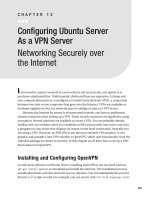Exposing an Existing Application As a Portlet
Bạn đang xem bản rút gọn của tài liệu. Xem và tải ngay bản đầy đủ của tài liệu tại đây (872.93 KB, 32 trang )
2840ch13.qxd 7/13/04 12:44 PM Page 307
CHAPTER 13
Exposing an Existing
Application As
a Portlet
I N THIS CHAPTER WE take an existing web application, the YAZD forum software, and
adapt it to provide a portlet front end. Initially, we install the forum software in its
unaltered state; then we show the decisions and changes we make in the process
of building the portlet.
Overview of the YAZD Forum Software
The YAZD forum software is available from as an open source
product under the Apache License. This means that you are allowed to make any
changes you want to the source code as long as you keep all of the original copyright messages and as long as you call your resulting product something different.
This software has quite a few rough edges. Sometimes errors will be displayed
to the user instead of being caught and handled nicely. The initial configuration
of the application is quite complex. However, the code is readily adaptable and
sensibly designed, and the flaws can be fixed in the process of adapting it to a portal
environment.
All the code used in this example is available from our web site (http://
portalbook.com/), and it is the aim of the authors to make a complete package
available.
Using YAZD
Before we embark on a conversion of the YAZD application, we need to install and
configure it for our purposes. If you want to get a feel for the behavior of the forums
before you install them, the YAZD support forums are hosted using YAZD itself.
Download at Boykma.Com
307
2840ch13.qxd 7/13/04 12:44 PM Page 308
Chapter 13
Installing
To install the YAZD forums, you will need to acquire a database, with a JDBC driver,
and an application server such as Tomcat. You will also need a copy of the YAZD
application. For our example we’ve used the MySQL database.
CAUTION The MySQL database is very popular for small projects—and
rightly so, since it is free, easy to configure, and runs on most platforms.
However, it has a number of limitations that should make you very cautious
about using it for larger projects.
If you need a free database for a large project, we recommend the PostgreSQL
system (though this is difficult to configure to run on Windows).
We recommend following the installation instructions available from http://
paperstack.com/yazd since these are slightly more comprehensive than those
available from the site.
Figure 13-1 shows what you should see once you’ve got the administration
side of things up and running.
Figure 13-1. The YAZD Administration console
308
Download at Boykma.Com
2840ch13.qxd 7/13/04 12:44 PM Page 309
Exposing an Existing Application As a Portlet
Configuring
Although the “general use” forums are mostly pretty slick, the forum administration
page is quite idiosyncratic (probably because it has received less feedback from
users). One particularly annoying bug causes a newly created forum to disappear
if you haven’t assigned it a moderator. To prevent this problem, we recommend
that you assign the default Administrator user all privileges immediately after creating a forum.
You should then assign “read messages” and “post messages” privileges to all
anonymous users.
Deciding What to Change
If you are building a portlet as a part of a large, well-funded project team—perhaps
portletizing a company’s premiere project—your aim in the process of portletization
will be to keep as much of the existing functionality as possible.
If like most project teams you have limited time and resources, you’ll be
looking to cut down the scope of the project as much as possible. For our example chapter, we will be drastically trimming functionality from that offered by the
complete YAZD forums—we will dispense with the user account management of
the system so that only unauthenticated (anonymous) users will have access to
the system. We will also omit the search functionality (based on Lucene, which we
discussed in Chapter 10).
This leaves our portlet as a tool to allow anonymous users to view and post
into the YAZD forums. The basic administration functionality required to create
new forums and assign privileges to anonymous users can still be accessed via
the original application, since all message and account information is stored in
the database.
Giving Up Control
Probably the first thing to remember when you sit down to design the portlet
version of an existing application is that your application is not the only game in
town. You have given up some control over your environment in return for the
additional features offered by that environment.
Your portlet doesn’t have the whole browser window to play with when it is
in its normal state, so you should endeavor to make it scale as nicely as possible.
You should also attempt to limit the amount of information displayed in the portlet so that it will fit into the available space without crowding out other portlets.
Download at Boykma.Com
309
2840ch13.qxd 7/13/04 12:44 PM Page 310
Chapter 13
Figure 13-2 shows what the application looked like before we started removing
functionality.
Figure 13-2. The application in its original state
Your portlet has some control over the window state, but you need to make
sure that it behaves in a consistent manner when the user clicks a link. Users won’t
want the application to flicker between normal, maximized, and minimized views
unpredictably. Indeed, if your application has a sufficiently adaptable GUI, you
might want to relinquish all control over the window state and let the user select
this through the portal decorations (maximize, minimize, and normal mode
“buttons”), which are usually added to the portlet content.
In our conversion of YAZD, we have decided that it is impractical to carry
out most of the functionality of the forums within the limited space likely to be
available in the normal window state. We will therefore display a summary of
the available forums in this state; then switch users to the maximized state when
they follow any of the links in the normal view. To ensure that we don’t fill the
normal view with dozens of available forums, we will limit the summary to the first
five forums available on the system.
Figure 13-3 shows what we end up with in the summary page after we’ve finished trimming down the application.
310
Download at Boykma.Com
2840ch13.qxd 7/13/04 12:44 PM Page 311
Exposing an Existing Application As a Portlet
Figure 13-3. The application as a portlet
In Figure 13-4, you can see how the portlet presents the expanded list of
forums once the More link is selected. Note that this is still not as wordy as
the pre-portletization version shown earlier.
Figure 13-4. The expanded portlet display
Download at Boykma.Com
311
2840ch13.qxd 7/13/04 12:44 PM Page 312
Chapter 13
Moving Around the Application
Most of the time, writing a portlet is not so different from writing a servlet, but in
one unexpected aspect they really are quite different: you cannot render URLs
directly if you want the link to appear within the portlet rather than as a page in
its own right.
NOTE Actually the authors are quite perplexed by just how difficult rendering
a portlet URL has been made—sufficiently so that we suspect this is largely an
oversight by the developers of the standard.
The YAZD application has a GUI primarily built from JSP pages, so our solution
to this problem has been to create a tag library specifically for rendering links so
that the directed page will appear within the portlet.
To recap, one of your tasks when converting an existing application into
a portlet will be to determine which links need to leave the user in the portlet
rather than directing to an external page, and then rewriting those links appropriately.
Displaying Screens in a Portlet
Our application is to operate as a single portlet, but we want to base it on an
application that was designed as a number of JSPs (effectively servlets). We could
reconcile the two by discarding the JSPs and rewriting the portlet based on the
business logic components, but this is a waste of perfectly good code.
Instead, we build a controller portlet that hides the implementation detail of
the JSP files and presents a single portlet for the portal to interact with.
Building Our Controller Portlet
Our controller portlet must be capable of receiving a render request, determining
from the parameters passed in which JSP page to dispatch the request to, and
responding to any other requests made by the portal during the portlet’s life cycle.
As it turns out, this is surprisingly simple:
package com.portalbook.forums;
import java.io.IOException;
import javax.portlet.GenericPortlet;
312
Download at Boykma.Com
2840ch13.qxd 7/13/04 12:44 PM Page 313
Exposing an Existing Application As a Portlet
import javax.portlet.PortletConfig;
import javax.portlet.PortletContext;
import javax.portlet.PortletException;
import javax.portlet.RenderRequest;
import javax.portlet.RenderResponse;
import javax.portlet.WindowState;
import com.Yasna.forum.Authorization;
import com.Yasna.forum.AuthorizationFactory;
import com.Yasna.forum.ForumFactory;
import com.portalbook.forums.tags.UrlTag;
public class ForumPortlet extends GenericPortlet
{
/**
* Calls the request dispatcher to include a specified JSP path
* in the portlet output.
*
* @param path The path to the JSP to include
* @param request The request object to pass in
* @param response The response object to pass in
* @throws PortletException Thrown if there is a
*
problem accessing the context
* @throws IOException Thrown if there is a
*
problem writing the page fragment
*/
private void include(String path, RenderRequest request,
RenderResponse response) throws PortletException, IOException
{
getPortletContext().getRequestDispatcher(path).include(request,
response);
}
Here’s where most of the work is done—the doView() method looks in the
parameters supplied with the request for an HREF (the JSP page) and the QUERY
(everything to be appended to the page). These are used to invoke a JSP page
stored in the WEB-INF directory, which therefore cannot be loaded directly by
the user.
The response from the page is rendered directly into the portlet’s response
stream.
The result is that we can invoke JSP pages quite simply with a minimal portlet.
Most of the additional effort involves adapting the JSP pages to remove unnecessary
or harmful tags (such as <html>), and rendering links and images. We discuss the
latter problems in the next section on building a tag library.
Download at Boykma.Com
313
2840ch13.qxd 7/13/04 12:44 PM Page 314
Chapter 13
/**
* Invoked by the portal to render our portlet. This should cause
* the content of an appropriate JSP page to be rendered within
* the portlet.
*
* @param request The request object from the invocation
* @param response The response object from this portlet
* @throws PortletException Thrown if there is a
*
problem accessing the context
* @throws IOException Thrown if there is a problem
*
writing the page fragment
*/
protected void doView(RenderRequest request, RenderResponse response)
throws PortletException, IOException
{
PortletContext context = getPortletContext();
WindowState state = request.getWindowState();
// Retrieve the JSP to direct to (if any)
// (formatted as "path/path/file.jsp")
String href = request.getParameter(UrlTag.HREF);
getPortletContext().log("Href retrieved: " + href);
// Retrieve the query to append (if any) (formatted as "?x=y&z=w")
String query = request.getParameter(UrlTag.QUERY);
getPortletContext().log("Query retrieved: " + query);
if ((href != null) && (query != null))
href += ("?" + query);
if (href == null)
href = VIEW;
if (state.equals(WindowState.NORMAL))
{
include(PORTLET_GUI + NORMAL + href, request, response);
}
else if (state.equals(WindowState.MINIMIZED))
{
include(PORTLET_GUI + MINIMIZED + href, request, response);
}
else if (state.equals(WindowState.MAXIMIZED))
{
include(PORTLET_GUI + MAXIMIZED + href, request, response);
}
314
Download at Boykma.Com
2840ch13.qxd 7/13/04 12:44 PM Page 315
Exposing an Existing Application As a Portlet
else
{
throw new PortletException(
"Unrecognized WindowState in View mode: "
+ state.toString());
}
}
/**
* Invoked by the portal to determine the title of
* the portlet. We return a string identifying the
* name of the portlet plus the number of forums
* available to the system.
*
* @param request The render request from the portal
* @return The title String
*/
protected String getTitle(RenderRequest request)
{
Authorization auth = AuthorizationFactory
.getAnonymousAuthorization();
int count = ForumFactory.getInstance(auth).getForumCount();
return forumName.trim() + " (" + count
+ ((count != 1) ? " forums)" : " forum)");
}
/**
* Initialize the configuration of the
* portlet.
*
* @param config The configuration object from which
*
configuration parameters should be
*
drawn.
*/
public void init(PortletConfig config) throws PortletException
{
super.init(config);
// Retrieve the name of the forums for display
forumName = config.getInitParameter(FORUM_NAME);
if (forumName == null)
forumName = "Portalbook";
}
Download at Boykma.Com
315
2840ch13.qxd 7/13/04 12:44 PM Page 316
Chapter 13
// The name of the forums
private String forumName;
// The configuration name in the portlet.xml file
private static final String FORUM_NAME = "title";
// The location (relative to the portal's webapp) from which to obtain
// the GUI components which are all written as JSPs
private static final String PORTLET_GUI = "/WEB-INF/skins/portalized/";
// The path in the skin directory containing the various
// window-state versions of the display
private static final String MINIMIZED = "minimized/";
private static final String MAXIMIZED = "maximized/";
private static final String NORMAL = "normal/";
// The paths in the appropriate skin directories for
// the mode views of the portlet
private static final String VIEW = "view.jsp";
// The identifier for an unknown user
private static final String UNKNOWN = "anonymous";
}
Building a Tag Library
As we’ve just discussed, our controller portlet looks out for the configuration
parameters HREF and QUERY and converts them into a URL, which if followed by
the user will render a page within the portlet.
The process of placing these configuration parameters into the JSP pages
that build the forum software is rather daunting, however, so we have chosen to
simplify the process by means of a custom tag library.
Our tag library will allow us to conveniently provide relative links to resources
to be displayed by the portlet. For example, to render the link to the image for the
Post New Message button used by the forums, we use the following tag:
While that looks a little cumbersome, the alternative is the following
nugget of JSP:
We think that does very little to improve the readability of a page. Our custom
tag at least has some similarity to the conventional HTML for an image tag.
Because this link-rewriting tag is the simpler of the two in our library, we’ll
examine its implementation first, and then we’ll take a look at the more complex
one. We’re assuming you’re familiar with the basics of tag libraries, so we’ll concentrate on the specifics of their interactions with the portlet container and our
controller portlet.
The Link-Rewriting Tag (href)
Because a portlet container is permitted to store information about the state of
its portlets in the URL used to invoke a page, a simple portlet can have a surprisingly complicated URL—which has no obvious correlation with the URL it occupies
on initialization.
Because of this, a relative URL like images/postnewmsg.gif cannot be used to
reference resources such as images that are not a part of the portlet itself. You
might think that you could work out what the “real” URL would be, but since the
mechanism used is not mandated by the standard, there’s no guarantee that your
solution would work on another platform.
To illustrate the mess this can make of your URL, the image mentioned if
rendered as a relative URL from the viewForum.jsp page in Pluto could end up
as (with line breaks introduced to fit it on the page):
http://localhost:8080/pluto/portal/test/_rp_test_row_col1_p3_href/1_post0x2jsp/
_st_test_row_col1_p3/normal/_md_test_row_col1_p3/view/
_pm_test_row_col1_p3/view/_ps_test_row_col1_p3/normal/
_rp_test_row_col1_p3_query/1_forum=2/_pid/
test_row_col1_p3/images/postnewmsg.gif
Obviously, there’s some method in this madness—we can make out the portlet mode (view) and window state (normal) in there, along with the parts of the
URL we tried to add directly, but it’s far from obvious that what should have been
provided was
http://localhost:8080/yazd/images/postnewmsg.gif
And even if you knew the rule that Pluto had used to create this, there’s no
reason to imagine that any other portlet container will use the same mechanism.
We must therefore use the mechanism that we described in the introduction
to this section, and we’ll build a tag to do this. The following class achieves this:
Download at Boykma.Com
317
2840ch13.qxd 7/13/04 12:44 PM Page 318
Chapter 13
package com.portalbook.forums.tags;
import java.io.IOException;
import javax.portlet.PortletRequest;
import javax.portlet.PortletResponse;
import javax.servlet.jsp.JspException;
import javax.servlet.jsp.tagext.TagSupport;
public class HrefTag extends TagSupport
{
/**
* Getter for the attribute used to dictate
* the path to be rewritten
*
* @param path The path to be rewritten as an absolute URL
*/
public void setPath(String path)
{
this.path = path;
}
/**
* Retrieves the attribute used to dictate
* the path to be rewritten
*
* @return The path to be rewritten
*/
public String getPath()
{
return this.path;
}
/**
* Ignores the body of the tag (there shouldn't be one)
* and generates an absolute URL for the provided path
* attribute relative to the context in which this
* portlet is running.
*
* @return SKIP_BODY
* @throws JspException if the output stream cannot be written
*/
public int doStartTag()
throws JspException
318
Download at Boykma.Com
2840ch13.qxd 7/13/04 12:44 PM Page 319
Exposing an Existing Application As a Portlet
{
try
{
String contextPath = ((PortletRequest) pageContext
.getRequest()).getContextPath();
String absolutePath = ((PortletResponse) pageContext
.getResponse()).encodeURL(contextPath + "/" + getPath());
pageContext.getServletContext().log("Path: " + path);
pageContext.getServletContext().log(
"Context path: " + contextPath);
pageContext.getServletContext().log(
"Absolute path: " + absolutePath);
pageContext.getOut().print(absolutePath);
return SKIP_BODY;
}
catch (IOException e)
{
throw new JspException(
"Could not write to the page buffer while expanding an href custom tag",
e);
}
}
// The field to store the path attribute
private String path;
}
The tag’s TLD entry follows:
<tag>
<name>href</name>
<tagclass>com.portalbook.forums.tags.HrefTag</tagclass>
<bodycontent>NONE</bodycontent>
<info>
Rewrite a relative URL so that it refers to the position in the page
relative to the portlet (this will remove any path information
donated by the portal to manage the portlet's state).
</info>
<attribute>
<name>path</name>
<required>true</required>
<rtexprvalue>true</rtexprvalue>
</attribute>
</tag>
Download at Boykma.Com
319
2840ch13.qxd 7/13/04 12:44 PM Page 320
Chapter 13
Note that we have flagged that the tag requires the path field (there’s no point
using the tag without specifying a path to rewrite), that it does not process any
body content, and that it should permit the evaluation of runtime expressions for
the path attribute, allowing the following sort of invocation:
The Link-Building Tag (url)
The more complex link-building tag is used to allow reasonably efficient generation
of links to components of the portlet as JSP pages without substantial rewriting
of the JSP page.
For example, the original page might provide a URL linking index.jsp to
viewForum.jsp thus:
viewForum.jsp?forum=<%=forumID%>
</pb:url>
Again, scripting variables must be expanded (although these are now most
likely to reside in the body of the tag). The mode attribute defines the PortletMode
that the portlet will be set to, and the state describes the WindowState that the portlet will be set to. We also supply the name of a scripting variable that we would like
to contain the generated URL (in fact, a PortletURL). This allows us to pre-declare
various links using the long syntax and then include them in the output in this way:
Download at Boykma.Com
2840ch13.qxd 7/13/04 12:44 PM Page 321
Exposing an Existing Application As a Portlet
package com.portalbook.forums.tags;
import javax.servlet.jsp.JspException;
import javax.servlet.jsp.tagext.BodyContent;
import javax.servlet.jsp.tagext.BodyTagSupport;
import javax.portlet.PortletMode;
import javax.portlet.PortletModeException;
import javax.portlet.RenderResponse;
import javax.portlet.PortletURL;
import javax.portlet.WindowState;
import javax.portlet.WindowStateException;
public class UrlTag extends BodyTagSupport
{
/**
* Getter for the scripting variable attribute
* @return The name of the scripting variable
*/
public String getVar()
{
return var;
}
/**
* The getter for the mode attribute
* @return The name of the mode to select
*/
public String getMode()
{
return mode;
}
/**
* The getter for the state attribute
* @return The name of the window state to select
*/
public String getState()
{
return state;
}
/**
* The setter for the scripting variable attribute
* @param var The name of the scripting variable
Download at Boykma.Com
321
2840ch13.qxd 7/13/04 12:44 PM Page 322
Chapter 13
*/
public void setVar(String var)
{
this.var = var;
}
/**
* The setter for the mode attribute
* @param mode The name of the mode to select
*/
public void setMode(String mode)
{
this.mode = mode;
}
/**
* The setter for the state attribute
* @param state The name of the state to select
*/
public void setState(String state)
{
this.state = state;
}
/**
* Determines an initial PortletURL object to refer to
* the current portlet context. The mode and state
* attributes are then extracted and applied to the
* PortletURL.
*
* EVAL_BODY_BUFFERED is returned so that the link to
* rewrite can be determined
*
* @return EVAL_BODY_BUFFERED
* @throws JspException Thrown if the desired mode
*
or state cannot be set.
*/
public int doStartTag() throws JspException
{
// Get the URL representing the portlet
PortletURL url = ((RenderResponse) pageContext.getResponse())
.createRenderURL();
// Get the desired mode and state (if not default) from
// the attributes
322
Download at Boykma.Com
2840ch13.qxd 7/13/04 12:44 PM Page 323
Exposing an Existing Application As a Portlet
PortletMode mode = getModeFromModeName(getMode());
WindowState state = getStateFromStateName(getState());
// Set the mode and state
try
{
if (mode != null)
url.setPortletMode(mode);
if (state != null)
url.setWindowState(state);
}
catch (PortletModeException e)
{
throw new JspException("Could not set portlet mode in url: "
+ mode);
}
catch (WindowStateException e)
{
throw new JspException("Could not set portlet state in url: "
+ state);
}
// Make the URL available as a page variable if
// the user has requested this.
if (getVar() != null)
{
pageContext.setAttribute(getVar(), url);
}
// Evaluate the body (for the link)
return EVAL_BODY_BUFFERED;
}
/**
* Retrieves the PortletURL created in the start tag
* and adds to it the HREF and QUERY parts of the
* desired path. The path is split into two parts because
* the Pluto portlet container (erroneously?) does not
* encode the '?' part of the parameter. This must therefore
* be removed from the parameter data - since otherwise it
* will be included in the URL when used to invoke the
* ForumPortlet and the ForumPortlet will only receive
* those parts of the invoking URL prior to the '?'
*
* Returns SKIP_BODY to indicate that the tag has
Download at Boykma.Com
323
2840ch13.qxd 7/13/04 12:44 PM Page 324
Chapter 13
* completed processing of the body.
*
* @return SKIP_BODY
* @throws JspException Thrown if the link cannot be retrieved from the body.
*/
public int doAfterBody() throws JspException
{
PortletURL url = (PortletURL) pageContext.getAttribute(getVar());
// Retrieve the content of the tag
BodyContent body = getBodyContent();
if (body == null)
{
throw new JspException("No body (link) provided in tag");
}
// Check that we've got a path !
String path = body.getString();
if (path == null)
{
throw new JspException("No path (link) provided in tag");
}
pageContext.getServletContext().log("UrlTag path=" + path);
// Determine the href part and the query part
// of the given relative (hopefully) URL.
int splitAt = path.indexOf('?');
// The HREF part is from the beginning of the string up to, but
// not including the '?' (or the whole string if there's no '?').
String href = (splitAt > 0) ? path.substring(0, splitAt) : path;
// The QUERY part is from immediately AFTER the '?' to the end
// of the string (or an empty string if there's no '?')
String query = (splitAt > 0) ? path.substring(splitAt + 1) : "";
// Add the parameters to the PortletURL
// ready for the user to obtain them.
url.setParameter(HREF, href);
url.setParameter(QUERY, query);
// We're done processing the body
return SKIP_BODY;
}
324
Download at Boykma.Com
2840ch13.qxd 7/13/04 12:44 PM Page 325
Exposing an Existing Application As a Portlet
/**
* Converts the state name as a String into
* the WindowState object representing it
*
* @param name The name of the state
* @return A WindowState representing the named state
* @throws JspException Thrown if a non-standard state name is provided
*/
private WindowState getStateFromStateName(String name)
throws JspException
{
if (name.equalsIgnoreCase(WindowState.MAXIMIZED.toString()))
{
return WindowState.MAXIMIZED;
}
else if (name.equalsIgnoreCase(WindowState.MINIMIZED.toString()))
{
return WindowState.MINIMIZED;
}
else if (name.equalsIgnoreCase(WindowState.NORMAL.toString()))
{
return WindowState.NORMAL;
}
else
{
// Tag can't handle non-standard states
throw new JspException("Can't handle non-standard state: "
+ name);
}
}
/**
* Converts the mode name as a String into
* the PortletMode object representing it
*
* @param name The name of the mode
* @return A PortletMode representing the named mode
* @throws JspException Thrown if a non-standard mode name is provided
*/
private PortletMode getModeFromModeName(String name)
throws JspException
{
if (name.equalsIgnoreCase(PortletMode.EDIT.toString()))
{
Download at Boykma.Com
325
2840ch13.qxd 7/13/04 12:44 PM Page 326
Chapter 13
return PortletMode.EDIT;
}
else if (name.equalsIgnoreCase(PortletMode.VIEW.toString()))
{
return PortletMode.VIEW;
}
else if (name.equalsIgnoreCase(PortletMode.HELP.toString()))
{
return PortletMode.HELP;
}
else
{
// Tag can't handle non-standard modes
throw new JspException("Can't handle non-standard mode: "
+ name);
}
}
// The field to contain the mode
// attribute (defaults to VIEW)
private String mode = "view";
// The field to contain the state
// attribute (defaults to NORMAL)
private String state = "normal";
// The field to contain the name
// of the scripting variable - this
// is a required field.
private String var = null;
/**
* Defines the parameter name for the HREF part
* of a URL
*/
public static final String HREF = "href";
/**
* Defines the parameter name for the QUERY part
* of a URL
*/
public static final String QUERY = "query";
}
326
Download at Boykma.Com
2840ch13.qxd 7/13/04 12:44 PM Page 327
Exposing an Existing Application As a Portlet
Simplifying the Screens
The JSP pages that we have inherited from the YAZD application are part of
a full-fledged web application. Our portlet is a small part of the portal. We need
to trim anything redundant from our pages.
First, we reduce the number of JSPs required. The original application was
formed from the following:
breadcrumb.jsp
createAccount.jsp
error.jsp
footer.jsp
header.jsp
index.jsp
login.jsp
post.jsp
search.jsp
toolbar.jsp
userAccount.jsp
userDetail.jsp
viewForum.jsp
viewThread.jsp
We can discard any pages that manage account information, such as login.jsp.
We have removed the search facility from our design, so search.jsp can go. We also
want our page to be an HTML fragment rather than a full page, so the header and
footer pages can be deleted. Our remaining set of pages is as follows:
error.jsp
index.jsp
post.jsp
toolbar.jsp
view.jsp
viewForum.jsp
viewThread.jsp
We’ll now discuss the purpose of these remaining pages in turn.
error.jsp provides error handling for the user should an unexpected problem
arise during processing of the application. We have implemented the bare minimum, and merely report the exception to the user. A professional application
should translate this into plain English for the user.
index.jsp provides the full listing of forums available to the user and permits
them to select a forum for a detailed view of the threads it contains.
Download at Boykma.Com
327
2840ch13.qxd 7/13/04 12:44 PM Page 328
Chapter 13
post.jsp is the page through which messages are added to the forums.
toolbar.jsp provides some functionality that is common to all of the major
pages.
view.jsp offers a summarized view of the forums available to the user. This is
the only page that we have added to the design.
viewForum.jsp provides a detailed view of the threads contained in a selected
forum.
viewThread.jsp provides a detailed view of the messages contained in a selected
thread.
Once selected, the screens are updated to remove any dependencies on the
removed pages, such as variables declared in the removed pages or URLs that
link into the removed pages. The implementation of our new view.jsp page follows
as an example.
First, we import the libraries that will be needed inline, and declare the page
that will handle exceptions thrown while generating the page:
<%@
page import="java.util.*,
com.Yasna.forum.*,
com.Yasna.forum.util.*"
errorPage="error.jsp"
%>
Now we import the tag library to aid in rewriting URLs, and initialize various
variables:
<%@ taglib uri="portalbook.tld" prefix="pb" %>
<%!
//////////////////////////////////
// customize the look of this page
// Colors of the table that displays a list of forums
final static String forumTableBgcolor = "#cccccc";
final static String forumTableFgcolor = "#ffffff";
final static String forumTableHeaderFgcolor = "#eeeeee";
%>
The next item of code obtains a token to identify the user. In our case, this will
be the anonymous user, so we have removed any identity checking and replaced
it with the following:
<%
Authorization authToken = AuthorizationFactory.getAnonymousAuthorization();
%>
328
Download at Boykma.Com
2840ch13.qxd 7/13/04 12:44 PM Page 329
Exposing an Existing Application As a Portlet
Now we obtain an object that we can use to retrieve information from the
forum software about the forums and the messages they contain:
<%
ForumFactory forumFactory = ForumFactory.getInstance(authToken);
User user = forumFactory.getProfileManager().getUser(authToken.getUserID());
long userLastVisitedTime = SkinUtils.getLastVisited(request,response);
%>
Next, we render the list of forums available, starting with the headings for the
table:
cellspacing="0"
border="0"
width="100%">
<td>
cellspacing="1"
border="0"
width="100%">
Download at Boykma.Com
329
2840ch13.qxd 7/13/04 12:44 PM Page 330
Chapter 13
<%
Iterator forumIterator = forumFactory.forums();
if( !forumIterator.hasNext() ) {
%>
int forumCount = 0;
while( forumIterator.hasNext() ) {
Forum forum = (Forum)forumIterator.next();
forumLoaded = true;
int forumID = forum.getID();
String forumName = forum.getName();
String forumDescription = forum.getDescription();
int threadCount = forum.getThreadCount();
int messageCount = forum.getMessageCount();
String creationDate = df.format(forum.getCreationDate());
String modifiedDate = df.format(forum.getModifiedDate());
%>
Since users will be able to select each of our links in turn to drill down into
a thread-level view of their chosen forum, we need to use our tag library to generate appropriate URLs to display the next JSP page within the portlet.
Figure 13-5 shows the view of the forum threads.
330
Download at Boykma.Com
2840ch13.qxd 7/13/04 12:44 PM Page 331
Exposing an Existing Application As a Portlet
Figure 13-5. Drilling down into a message thread
Note the declaration of the scripting variable in the var attribute of the tag,
and the subsequent use of it to render a link for the forum name:
var="link">
viewForum.jsp?forum=<%=forumID%>
</pb:url>
<td><i><%= (forumDescription!=null)?forumDescription:" " %></i></td>
<td nowrap align="center">
<small class="date"><%= modifiedDate %></small>
</td>
</tr>
If more than five forums are available to users, we will list the first five, then
make a link available to users that they can select to view the rest. This restricts
the amount of space taken up by our portlet in its “normal” viewing mode.
<%
if( ++forumCount > 4 ) {
%>
</tr>
<%
Download at Boykma.Com
331



